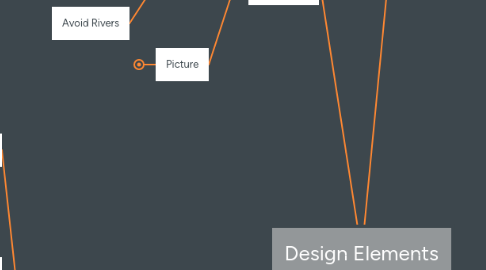
1. Line
1.1. Functions
1.1.1. Connector
1.1.2. Seperator
1.1.3. Graphs/Grids
1.2. Characteristics
1.2.1. Width
1.2.1.1. Thick
1.2.1.2. Thin
1.2.1.3. Tapering
1.2.1.4. Uneven
1.2.2. Length
1.2.2.1. Long
1.2.2.2. Short
1.2.2.3. Continuous
1.2.2.4. Broken
1.2.3. Direction
1.2.3.1. Horizontal
1.2.3.2. Vertical
1.2.3.3. Diagonal
1.2.4. Focus
1.2.4.1. Sharp
1.2.4.2. Fuzzy
1.2.4.3. Blurry
1.2.4.4. Choppy
1.2.5. Feeling
1.2.5.1. Sharp
1.2.5.2. Jagged
1.2.5.3. Graceful
1.2.5.4. Smooth
1.3. Types
1.3.1. Outlines
1.3.1.1. Lines Made By the Edge of an Object
1.3.2. Contour Lines
1.3.2.1. Lines That Describe Depth
1.3.3. Gesture Lines
1.3.3.1. Lines That Are Energetic and Capture Motion
1.3.4. Sketch Lines
1.3.4.1. Lines That Capture the Appearance of an Object
1.3.5. Calligraphic Lines
1.3.5.1. Elegant Handwriting
1.3.6. Implied Lines
1.3.6.1. Line is Not Actually Drawn
1.4. Picture
1.4.1. https://dab1nmslvvntp.cloudfront.net/wp-content/uploads/2009/10/LineTypes.png
2. Space
2.1. Definition
2.1.1. Area that other elements occupy
2.2. Tips
2.2.1. Don't Trap White Space
2.2.2. Keep Text Cells Small
2.2.3. Avoid Rivers
2.3. Picture
2.3.1. http://1.bp.blogspot.com/-pEZF0a-Rwmc/TyOTd9nl5NI/AAAAAAAAEU0/oxR6rVQzCHw/s1600/negativespace-vase1.jpg
3. Size
3.1. Function
3.1.1. Different Sizes for Different Age Groups
3.1.2. Younger People and Elderly People Will Most Likely Want Bigger Fonts so That It's Easier to Read
3.1.3. Make Things More Attractive by Making Them Larger
3.1.4. Make Important Elements Large and Lesser Important Things Small
3.2. Picture
3.2.1. http://www.vanseodesign.com/blog/wp-content/uploads/2010/07/size.png
4. Shape
4.1. Types
4.1.1. Geometric
4.1.1.1. Triangles
4.1.1.2. Squares
4.1.1.3. Circles
4.1.2. Natural
4.1.2.1. Animals
4.1.2.2. Plants
4.1.2.3. Humans
4.1.3. Abstract
4.1.3.1. Simplified Versions of Natural Shapes
4.2. Categories
4.2.1. Geometric
4.2.1.1. Shapes
4.2.2. Organic
4.2.2.1. Things In Nature That Have Irregular Characteristics
4.2.3. Positive
4.2.3.1. Solid Forms
4.2.3.2. Space That's Being Used
4.2.4. Negative
4.2.4.1. Space That Isn't Positive Space
4.2.4.2. Can Become Positive Space Where It Meets Positive Space
4.2.5. Static
4.2.5.1. Shapes That Appear Stable and Resting
4.2.6. Dynamic
4.2.6.1. Shapes That Appear to be Moving and Active
4.3. Picture
4.3.1. https://d3ui957tjb5bqd.cloudfront.net/uploads/2013/11/2dshape_2d_shape-560x368.jpg
5. Color
5.1. Definition
5.1.1. Visible Light Only Small Part of the Electromagnetic Spectrum
5.1.2. Humans Are Limited by Our Eyes to How We Can Perceive the World
5.2. Functions
5.2.1. Attract the Eye
5.2.2. Primary Tool for Symbolism
5.2.3. Provoke Emotional Response
5.3. Picture
5.3.1. https://www.studiobinder.com/wp-content/uploads/2016/09/2-How-to-Use-Color-in-Film-Example-of-Movie-Color-Palette-and-Schemes-Color-Theory-Film-Monochromatic-Complementary-Analogous-and-Triadic-min.png?x76747
6. Texture
6.1. Definition
6.1.1. Look of an Object
6.1.2. Feel of an Object
6.2. Types
6.2.1. Visual
6.2.1.1. Illusion
6.2.2. Tactile
6.2.2.1. Physical to Touch
6.3. Categories
6.3.1. Real
6.3.2. Implied
6.4. Picture
6.4.1. http://mbitwebpagedesign.com/wp-content/uploads/2014/07/LINE.jpg

